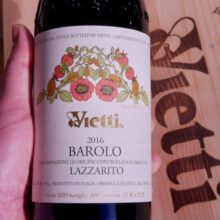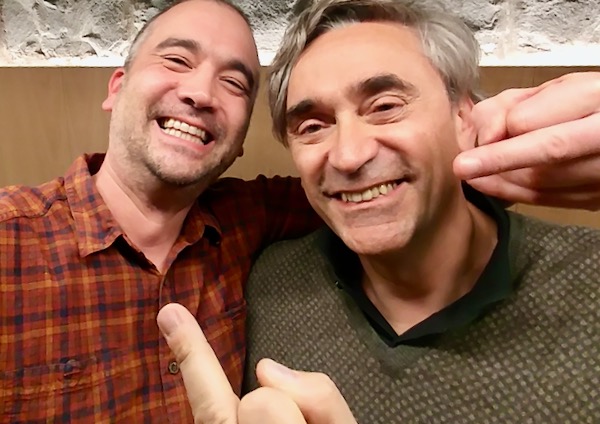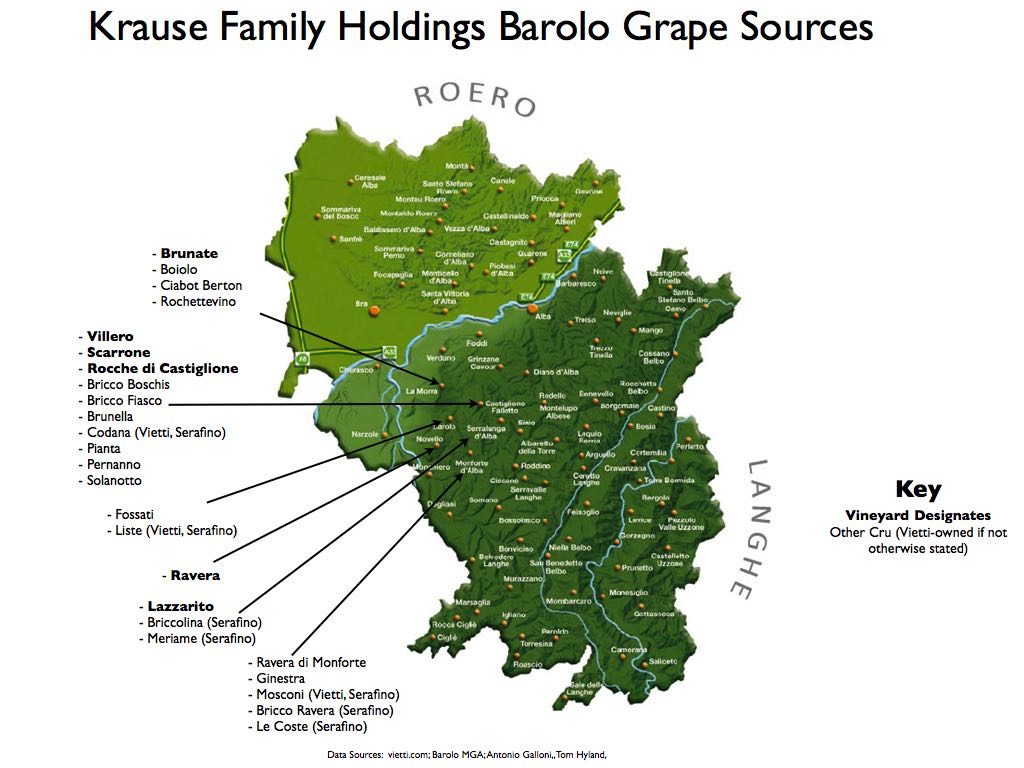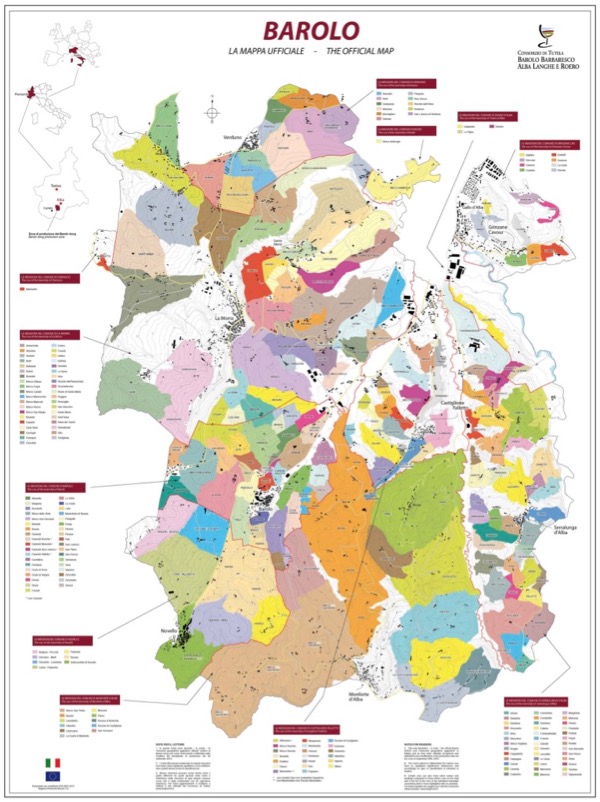
Product information
Vietti Barolo ‘Lazzarito’ 2016
$480
Only 1 left in stock
Size & Type
Other

$480
Only 1 left in stock
Grapes: 100% Nebbiolo
Winemaking: The grapes are selected from the single vineyard Lazzarito in Serralunga d’Alba, planted with roughly 4500 units per hectare. The vines have an average age of 35 years. The 2-hectare vineyard has a southwest exposure and a clay-limestone soil. Grapes are gently crushed and fermented for 4 weeks in stainless steel tank with skin contact. This time includes pre- and post- fermentative maceration with the traditional method of submerged cap. Malolactic is done in oak.
Ageing: The wine is aged for approximately 30 months between French oak barriques and Slovenian oak casks
Description: Deep garnet red in color. Richly rounded with a robust and velvety texture; intensely aromatic with hints of figs and plums. Elegant with soft and sweet tannins, followed by a long finish.
Luca & Elena have always stayed true to their convictions, and, history, acknowledging the wisdom of their family, and elder peers. While their Cru Barolos have brought them international fame, they have worked to protect patches of history for both their family and the region. Listen to Luca share his stories of retaining the Scarrone vineyard planted to Barbera when his father had planned to replant it to Nebbiolo, saving Arneis from being reconciled to a note in a wine book, and, more recently going back to Barbaresco, acquiring a parcel or Rabajà, and this becomes clear.

The drive for constant improvement continues with a parcel of Monvigliero now in the stables, whole bunch techniques are being applied with the help of Jeremy Seysses from Dujac. Meanwhile, Vietti has released it’s first Timorasso, a wine that I am looking forward to trying. Grapes for this white coming from vineyards located in Monleale in the Alessandria Province.
Luca and Elena are part of the perfect storm, mature vineyards, great sites, the hard work and detail needed to produce quality fruit, and, the experience to make the most of what a vintage has to throw at them!
Vietti’s 2016 Barolos are stratospheric. I have been following the wines for several years, first as separate lots, then as young wines in barrel. In all of those tastings, the wines were never anything less than mesmerizingly beautiful and full of potential. Now that they are in bottle, that potential has been realized. These are, quite simply, the most monumental wines I have tasted in twenty years of visiting the estate.
Galloni
Back in 2005, I spent some time at Vietti. Their winery sits in the castle atop Castiglione Falletto. It’s walls broken by slit windows for archers to defend the grounds. The escape tunnel leading from the castle to the plains below had been filled in only a few years prior to my visit. Somehow they’ve managed to modernise aspects of the winery carving into the rock without collapsing the ancient buildings surrounding it.

One of my earlier experience of Vietti was at the Australian Wine Research Institutes Advanced Wine Assessment Course. A blind bracket of 9 Nebbiolo’s was presented, Vietti’s Perbacco from 1998 and Brunate from 1996. The Brunate was superb. My notes from the tasting read “Very complex, great harmony, texture, rich, long, very together, perfumed, incredible layers and vibrancy.” The Perbacco excellent, particularly at 1/8th the price. “Great purity, balance, and poise. Supple with an excellent core of fruit and lovely floral notes.”
In many ways, little has changed. Perbacco, typically declassified Barolo, is the wine to crack while you’re waiting for your Barolo to mature!
Vietti intrigues me. Some of the best Barolo I have devoured have come from their winery. Watching the wines evolve over time, both the same vintage and across vintages has been fascinating. Modern technology at times pierced the tradition. Last year a vertical tasting going back to 1982 was fascinating. It again highlighted my growing consensus that the drinking window for good Barolo, from great years, starts at around 10 years and is right in the zone between 15 and 20 years.
Whilst Vietti have always produced more structured wines, the wines have always shown harmony and balance. The difficult 2011 year was perhaps a sign of a maturity and wisdom in the winemaking. They guided the fruit to a state of great harmony and balance in that year, pulling back on the structural elements to produce wines that were drinking superbly in late 2016.
In the last couple of years, I have devoured many more Vietti wines including a 1996 Villero Riserva and 1997 Rocche di Castiglione. Both would be in the top dozen Barolos I’ve every been lucky enough to devour!
Luca and Elenor’s wisdom has continued to build in the following years. Year after year the wines are getting better and better.
The Krause Family bought Vietti a couple of years back, leaving, Luca and the Family in full control of production, hence the name below. The winery based in Castiglione Falletto now has additional vineyard sources in Barolo with Monvigliero in Verduno in the very North of the Barolo region, Rabajà in the Barbareco, and, Timorasso plantings in the Colli Tortonesi, the most eastern part of Piedmont. In addition, they have plantings in the Roero and Asti (the Barbera d’Asti Tre Vigne is a cracker).


This 3D flyover is Epic covering each of the communes you can see just how varied and extreme the aspect of each vineyard is and how in the space of a few metres just how dramatically the change.
2016 has come at just the right time. We have a number of winemakers with incredible experience and wine wisdom. The vineyards in Barolo are in the best condition they’ve been in with incredible detail going into their care.
Combined we have a situation where vignerons are in the best possible position to make the most of the great fruit yielded by the 2016 harvest!
When you compare the 2015 & 2016 vintages you see the difference between a warmer vintage with a shorter ripening period and a cooler one with the longest ripening period in memory.
Nebbiolo responds beautifully to a cooler longer ripening. Once it reaches sugar level high enough to make a wine around 14-14.5% alcohol the sugar levels stop increasing, it tends to hold its acid and the tannins so important to the insane mouthfeel of Nebbiolo ripen and increase in depth.
Such vintages tend to offer wines with more perfume, energy, and, vitality.
From Galloni
Vietti’s 2016 Barolos are stratospheric. I have been following the wines for several years, first as separate lots, then as young wines in barrel. In all of those tastings, the wines were never anything less than mesmerizingly beautiful and full of potential. Now that they are in bottle, that potential has been realized. These are, quite simply, the most monumental wines I have tasted in twenty years of visiting the estate. Luca Currado told me yields were around 52 hectoliters per hectare, which is to say in line with years like 2013, but lower than 2004 or 2010, for example, both of which were more bountiful.
The 2016s represent another major step towards a style that melds together a level of textural richness that is quite contemporary with winemaking that is heavily traditional, a combination that works brilliantly, as readers can see from these notes. The first step in this direction was the 2010 Barolo Ravera, which was done entirely in cask, with no French oak for the malolactic fermentation, a departure from the days when all the Barolos spent about six months in French oak barrique. These days, the Barolos follow the same process, which is to say they are raised entirely in cask. The Lazzarito is an exception; it tends to have a very fast malo that often takes place alongside the alcoholic fermentation. It then sees about three months in French oak (10% new), done to soften the Serralunga tannins, before finishing the rest of its aging in cask. The 2016s saw 30-40 days on the skins, a few days longer than normal, with submerged cap fermentation. Kudos to Luca and Elena Currado, along with their longtime cellarmaster, Eugenio Palumbo, for a set of truly epic wines that will define their legacy at Vietti.
The first step in this direction was the 2010 Barolo Ravera, which was done entirely in cask, with no French oak for the malolactic fermentation, a departure from the days when all the Barolos spent about six months in French oak barrique. These days, the Barolos follow the same process, which is to say they are raised entirely in cask. The Lazzarito is an exception; it tends to have a very fast malo that often takes place alongside the alcoholic fermentation. It then sees about three months in French oak (10% new), done to soften the Serralunga tannins, before finishing the rest of its aging in cask.
The 2016 Barolo Lazzarito is another stunning wine in this range. The 2016 is the first vintage of the Lazzarito I can remember tasting in which intensely mineral notes accompany the more savory, earthy notes that are so typical of this site. Graphite, sage, dried flowers, crushed rocks, menthol, dried rose petal, mint, licorice and blood orange race out of the glass in a breathtaking, towering Barolo that hits all the right notes from the start to its chiseled, strikingly detailed finish. The 2016 Lazzarito is one of the most classically austere wines in this range. In a word: Magnificent.
Where in the world does the magic happen?
Vietti, Piazza Vittorio Veneto, Castiglione Falletto, Province of Cuneo, Italy
You must be logged in to post a comment.